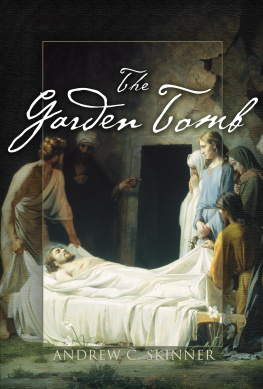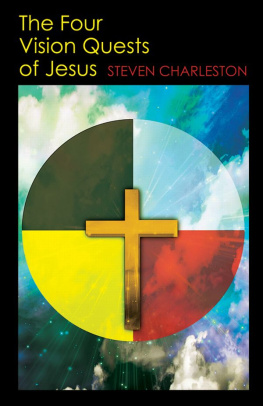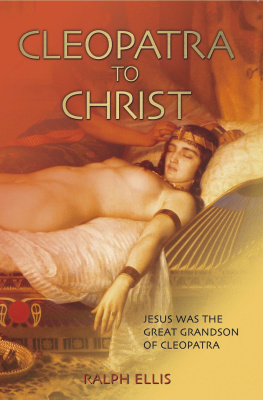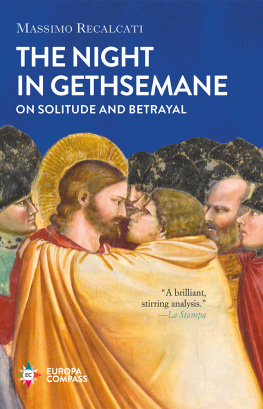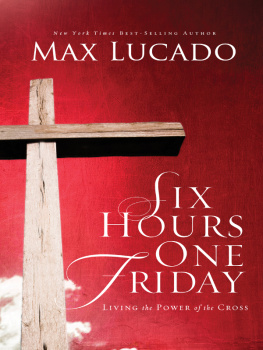Fr. Ralph Gorman - The Last Hours of Jesus: From Gethsemane to Golgotha
Here you can read online Fr. Ralph Gorman - The Last Hours of Jesus: From Gethsemane to Golgotha full text of the book (entire story) in english for free. Download pdf and epub, get meaning, cover and reviews about this ebook. year: 2017, publisher: Sophia Institute Press, genre: Religion. Description of the work, (preface) as well as reviews are available. Best literature library LitArk.com created for fans of good reading and offers a wide selection of genres:
Romance novel
Science fiction
Adventure
Detective
Science
History
Home and family
Prose
Art
Politics
Computer
Non-fiction
Religion
Business
Children
Humor
Choose a favorite category and find really read worthwhile books. Enjoy immersion in the world of imagination, feel the emotions of the characters or learn something new for yourself, make an fascinating discovery.

- Book:The Last Hours of Jesus: From Gethsemane to Golgotha
- Author:
- Publisher:Sophia Institute Press
- Genre:
- Year:2017
- Rating:5 / 5
- Favourites:Add to favourites
- Your mark:
- 100
- 1
- 2
- 3
- 4
- 5
The Last Hours of Jesus: From Gethsemane to Golgotha: summary, description and annotation
We offer to read an annotation, description, summary or preface (depends on what the author of the book "The Last Hours of Jesus: From Gethsemane to Golgotha" wrote himself). If you haven't found the necessary information about the book — write in the comments, we will try to find it.
The Last Hours of Jesus: From Gethsemane to Golgotha — read online for free the complete book (whole text) full work
Below is the text of the book, divided by pages. System saving the place of the last page read, allows you to conveniently read the book "The Last Hours of Jesus: From Gethsemane to Golgotha" online for free, without having to search again every time where you left off. Put a bookmark, and you can go to the page where you finished reading at any time.
Font size:
Interval:
Bookmark:
Fr. Ralph Gorman, C.P.
The Last
Hours
of Jesus
From Gethsemane
to Golgotha
SOPHIA INSTITUTE PRESS
Manchester, New Hampshire
Copyright 2017 by Sophia Institute Press
The Last Hours of Jesus was formerly published by Sheed and Ward, New York, in 1960. This 2017 edition by Sophia Institute Press includes minor editorial revisions.
Printed in the United States of America. All rights reserved.
Cover design by Coronation Media.
On the cover: Altarretabel von San Zeno in Verona (1459), by Andrea Mantegna; image courtesy of Wikimedia Commons.
Scripture citations are taken from the Confraternity Version of the Bible.
No part of this book may be reproduced, stored in a retrieval system, or transmitted in any form, or by any means, electronic, mechanical, photocopying, or otherwise, without the prior written permission of the publisher, except by a reviewer, who may quote brief passages in a review.
Nihil obstat : Richard Kugelman, C.P., S.T.L., S.S.L.
Imprimi potest : V. Rev. Canisius Hazlett, C.P.
Nihil obstat : John R. Ready, Censor Librorum , November 22, 1959
Imprimatur : Robert F. Joyce, Bishop of Burlington, November 23, 1959
Sophia Institute Press
Box 5284, Manchester, NH 03108
1-800-888-9344
www.SophiaInstitute.com
Sophia Institute Press is a registered trademark of Sophia Institute.
Library of Congress Cataloging-in-Publication Data
Names: Gorman, Ralph, author.
Title: The last hours of Jesus : from Gethsemane to Golgotha / Fr. Ralph
Gorman, C.P.
Description: Manchester, New Hampshire : Sophia Institute Press, 2018.
Originally published: New York : Sheed & Ward, 1960. Includes
bibliographical references.
Identifiers: LCCN 2017044646 ISBN 9781622824700 (pbk. : alk. paper) ePub ISBN 9781622824717
Subjects: LCSH: Jesus Christ Biography Passion Week.
Classification: LCC BT431.3 .G67 2018 DDC 232.96 dc23 LC record available at https://lccn.loc.gov/2017044646
Contents
Biographical Note:
Preface
I have not written this book for Scripture scholars, who have the same access as I have to sources of information on the Passion of Jesus Christ. I have directed it to nonspecialists who would like a fuller treatment of the Passion than is found in the great lives of Christ, such as those by Lagrange, Prat, Lebreton, Fillion, and Ricciotti. I have used their works, of course, as well as the best commentaries on the Gospels and various treatises on aspects of the Passion in English, Latin, French, German, and Italian. It has been my effort to tell the story of the last hours of Jesus accurately and in a manner interesting and intelligible to the ordinary reader. The description of some scenes may appear fictionized but is based on information concerning the period, places, and persons involved.
The four Gospels are the main source for the history of the Passion. New Testament quotations are from the Confraternity edition and are used with the permission of the Confraternity of Christian Doctrine. Background information is provided by the Mishnah and by early historians. For archeological data, I have used freely the lectures and writings of Pre Vincent, greatest of all Palestinian archeologists and my former professor at the cole Biblique in Jerusalem, where it was my privilege to do postgraduate studies for three years.
I wish to express my gratitude to my friends and fellow religious, Fathers Richard Kugelman, C.P.; Hilary Sweeney, C.P.; and Barnabas Aherne, C.P., for valuable and constructive criticism. Special thanks are due Miss Claire Foy, editorial assistant of the Sign, for typing the manuscript and for many helpful suggestions.
Prologue
Chapter 1

The Background
The story of Jesus last hours properly begins at the Garden of Gethsemane. Here begins His Passion, in that frightful agony wherein the God-Man almost seemed to have been rejected by His Father even as He was neglected by His sleeping Apostles.
And here, too, strengthened at the end of His agony, Jesus confronts His enemies, the antagonists in the tragic yet soaring drama of His suffering and death: the religious leaders of His Chosen People and Judas Iscariot, one of his chosen Twelve, who had betrayed Him for a price.
How could such a thing come to pass? How could anyone harm a man who traveled around the country with a few poor disciples, teaching about the Kingdom of God, working wonders in healing the sick, proclaiming a doctrine of love of God and neighbor? How could such a man be betrayed by one of His closest followers, arrested like a thief in the night, condemned by the highest court of the Jews, condemned again and sentenced to death on the cross by the highest Roman authority?
That mystery needs some explanation. To understand how such a thing could happen, it is necessary to know something of the ideas and institutions of the Jews at the time of Christ, and especially to understand two Jewish sects, the Sadducees and the Pharisees. It is also necessary, against this background, to probe the psychology of Judas, that enigma of perfidy.
The military threat from their neighbors was not the only menace to the Jews during several centuries before the birth of Christ. Pagan Greek culture and philosophy threatened to destroy the monotheistic religion of the Chosen People. Hellenizing influences pressed in upon them from all sides. The Sadducees and Pharisees owed their origins in large measure to the varied reaction to this threat.
The Pharisees reacted strongly against the pagan influences and clung tenaciously to the Mosaic Law. As the name itself indicates in Aramaic, the language of Palestine at that time, the Pharisees were separatists. This may have been a nickname given them by others. They called themselves Haberim (comrades), or the pious. They were called separatists because they kept themselves apart from anything that might render them legally impure, even the people of the land who were impure because they found it impossible to observe all the legal purifications practiced by the Pharisees.
The Pharisees were probably the descendants of the Assideans, mentioned at the time of the Maccabees. They were a religious rather than a political party, and their religion was strongly nationalistic. We have little information on their organization, but it is likely that candidates passed through a period of trial before becoming full-fledged members.
At the very heart of the party were the Scribes, although it is a mistake to identify Scribes and Pharisees. There were Scribes who were Sadducees. For the most part, however, the Scribes were Pharisees trained in the knowledge of the Law and its application. In fact, the most important characteristic of the Pharisees was their claim to know the Law better than anyone else, their rigor in practicing it, and their determination to impose it on others. They emphasized three points of the Law in particular: observance of the Sabbath, legal purifications, and the payment of tithes to Levites and priests.
By the time of Christ, the Pharisaical Scribes had developed an extremely complex and detailed oral law that, theoretically, expounded and applied the Torah. This mass of legal tradition was declared to be as binding as the Torah itself. Finally, a point was reached where it was considered more blameworthy to teach contrary to the precepts of the Scribes than contrary to the Law of Moses. The observance of the dictates of the Scribes became an end in itself, to which all other moral and religious considerations were secondary. Toward the close of the second century after Christ, the rabbis began to consign the teaching of the Scribes to writing, in works that developed into the Jerusalem and Babylonian Talmuds. A cursory reading of the Talmuds reveals the casuistic hair-splitting of the Scribes, as well as the complicated mesh of man-made traditions and observances in which they entangled their followers. Nevertheless, it was the knowledge and observance of these legal minutiae that constituted the perfection to which the Pharisees aspired.
Next pageFont size:
Interval:
Bookmark:
Similar books «The Last Hours of Jesus: From Gethsemane to Golgotha»
Look at similar books to The Last Hours of Jesus: From Gethsemane to Golgotha. We have selected literature similar in name and meaning in the hope of providing readers with more options to find new, interesting, not yet read works.
Discussion, reviews of the book The Last Hours of Jesus: From Gethsemane to Golgotha and just readers' own opinions. Leave your comments, write what you think about the work, its meaning or the main characters. Specify what exactly you liked and what you didn't like, and why you think so.


